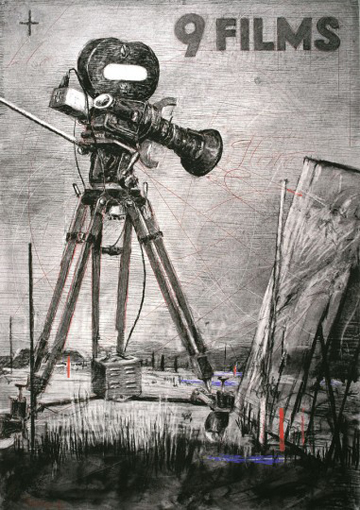[youtube:https://www.youtube.com/watch?v=rL3lVDrqNXY]
Using variable media – taking the form of tapestry and sculpture to performance, cinema, and stereoscopic imagery— William Kentridge calculates a not so obvious curve to create socially informed work that challenges the way we look.
In early October, the Henry Art Gallery participated in a preview screening of Art21’s William Kentridge: Anything is Possible. To celebrate the upcoming release, the Henry invited local animator Tess Martin to teach an all-ages animation workshop, inspired by Kentridge’s work. The workshop allowed participants to explore the creative process behind a modified base, a technique used by the artist in his many animated films. Following a brief introduction to the history of stop-motion, from flip books to Victorian parlor toys to Muybridge, workshop participants were asked to experiment with three mediums – charcoal/pastels, paint, and grain – to create a collaborative film.
Participants, mostly twenty-something adults, came from a variety of backgrounds including drawing, film, video, and digital animation. Pens and notebooks in hand, each brought with them a sense of eagerness and a variety of questions about the animation process. While many focused on the practicality of production, there were some participants who seemed more interested in the process of animation and what it means to animate an idea. This led to a later conversation around Kentridge’s use of animation, and his practice as a whole, as a tool for exposing the viewer to the act of seeing. Taking a cue from the film, one participant pointed out how Kentridge used found materials and familiar objects to create fantastical situations in which the viewer is made aware that they are looking, that they have control of what they see and how they interpret it. This realization brought up an interesting correlation between this awareness of seeing and the socio-cultural context of much of Kentridge’s work.

William Kentridge. "9 Drawings for Projection (1989–2003)," 2005. Copyright and courtesy of William Kentridge.
In addition to his love of music and theatre, Kentridge was largely influenced by his personal history growing up in South Africa. His work uses elements of theatricality to explore themes of history, oppression, and social inequality in a way that calls into question the nonsensical nature of bigotry. Through a carefully crafted combination of humor, whimsy, and the absurd, he is able to intimately address topics that might otherwise make audiences restless or uneasy. He does this, not by masking the issue at hand, but by creating a third space in which the viewer is better able to face the issue without reservation. In the tradition of many animators and artists before him, Kentridge has developed an uncanny ability to simultaneously call attention to both material and subject matter by creating a space for viewers to consider the act of seeing – getting just close enough to the subject to distort our discomfort and push us to make sense of what we are truly seeing, both literally and figuratively.
Art is often used as a means to convey material that is, for reasons of ill nature or physical impossibility, otherwise difficult to convey. Choosing to focus on the “universality of laughter” over “the particularity of tears” allows Kentridge to communicate socially relevant subject matter in a way that is accessible. But what is it about animation that dissolves our natural tendency toward judgment? Why is it easier to confront a near facsimile of an idea rather than face it in the flesh?
As a medium, stop-motion animation is a method of deconstructing and reconstructing the reality it portrays, maintaining a dual sense of both the familiar and the foreign– allowing the viewer to critically assess both the content and context of the work without reservation. Though animation is only part of Kentridge’s practice, it is a rich example of his interest in “machines that tell you what it is to look, that make you aware of the process of seeing.” Kentridge’s machines and methodologies encourage us to be aware of how we construct the world through looking at it, and encourage us to consider “looking and seeing as being a metaphor for how we understand the world.”




Pingback: FLASH POINTS: Art21 « Hankblog